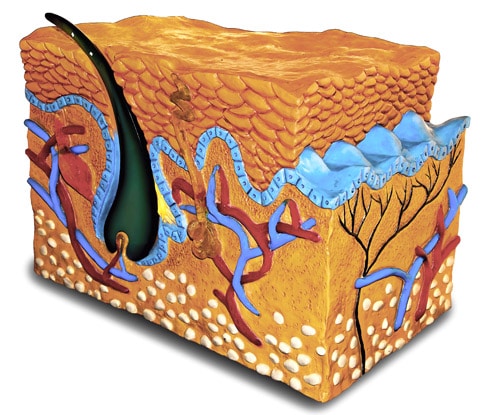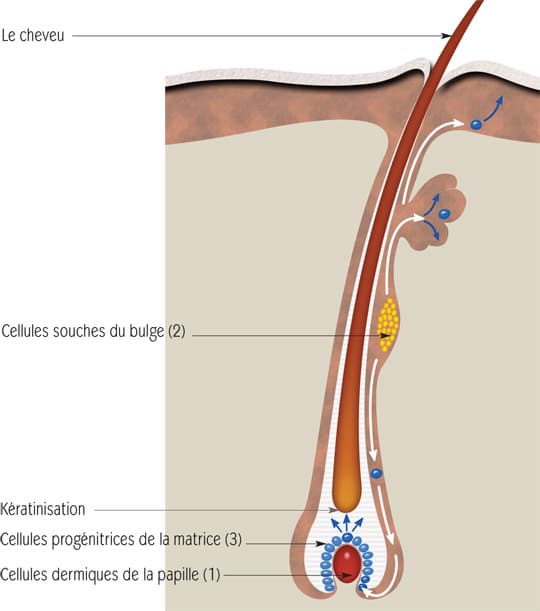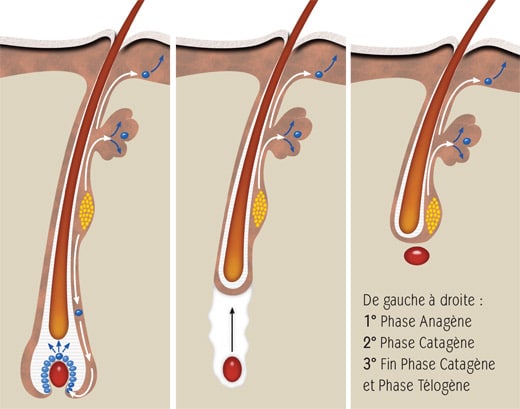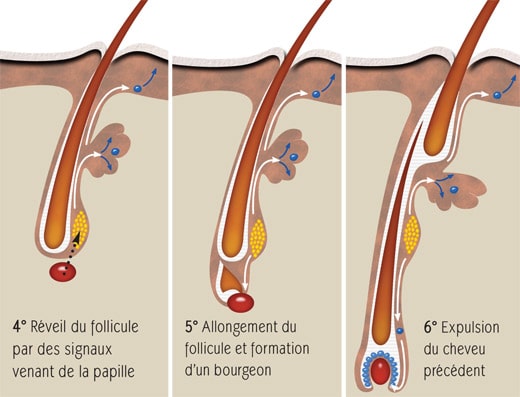The hair follicle is a small pocket of epidermis (in blue above), where the hair develops and where its root is located (in black). The only living organ that can die and come back to life in a perfectly autonomous and cyclical way, the hair follicle represents a unique entity in the human body. Since the beginning of this century, immense progress has been made in understanding its cells and their function. the capillary cycles it regulates.
Every year, new scientific research into its molecular biology provides a better understanding of how it works and how to combat the development of hair loss.
A FEW DEFINITIONS
- Molecular biology: Study of living organisms based on the macromolecules that make up their cells.
- CELL: The basic structure of all living organisms. It is no bigger than a few hundredths of a millimetre.
- MOLECULE: Smallest part of a substance.
- PROTEIN: Organic macromolecule.
CELLS THAT PREPARE FOR HAIR PRODUCTION
The hair follicle is home to three different types of cell. All three have clearly defined roles in the preparation of hair production.
1° Dermal cells of the papilla (fibroblasts)
It is these proteins that attach the follicle to the rest of the body throughout the anagen phase of hair growth. Their proteins are the real control towers for this growth, emitting a profusion of signals that represent commands to start, maintain or end hair growth.
2° Epithelial stem cells
Gathered in the bulge, they form a reservoir under the sebaceous gland. These cells are indefinitely divisible and pluripotent (multipurpose, like embryonic cells). Depending on the orders they receive, they may be the source of hair keranocytes or sebocytes of sebum.
3° Epithelial progenitor cells, located in the matrix at the base of the follicle
These cells are larger and more mature. Unlike stem cells, their number of divisions is limited in time (the length of a hair's life cycle) and they are focused solely on hair production. To do this, throughout the anagen phase, they feed the hair shaft and the two epithelial sheaths, one internal and one external, which surround the shaft and act as a support.
In the matrix, the progenitor cells multiply and divide relentlessly from mother cells to daughter cells (keratinocytes). All this takes place at an unbridled rate of around 48 hours, which is the fastest rate of reproduction in the body. In fact, new daughter cells are born and tirelessly drive out the previous ones, which then die, harden and migrate upwards in a row. This piling up of dead cells, known as keratinisation or keratogenesis, constitutes keratin. and forms the surface of the hair shaft.
ANAGEN PHASE: CONTINUOUS GROWTH
Throughout the anagen phase, hair growth is continuous, with the activity of the different cells in the follicle taking place in a perfectly ordered sequence:
- The dermal cells of the papilla send signals to the...
- to the stem cells of the bulge. These cells transform...
- into matrix progenitor cells, which divide ...
- from mother cells to daughter cells, generating...0
- the hair line
This line will only die out at the end of the life cycle to which it belongs. Its duration can vary between 2 and 6 years, depending on the sex and genetic capital of each individual.
CATAGEN PHASE, KEY PHASE
To understand how a new hair is born and develops, scientists have analysed the catagen phase (degradation) of the hair that the new growth will replace. This is a key phase in the explanation of the hair renewal cycle.
During this phase, which can last 2 to 3 weeks, the matrix dies, the hair progenitor cells disappear and the "heart" of the follicle stops beating. However, the follicle retains its reservoir of stem cells in its remains. It rises towards the epidermis, taking the hair with it (sketch no. 2). By the end of the catagen phase, its length will have been halved (sketch 3).
The dermal cells of the papilla remain intact but lose all contact with the follicle. The stem cells are then said to be quiescent (dormant) because there is no longer any stimulus from the papilla to stimulate them or allow them to proliferate. The papilla itself will move upwards and position itself very close to what remains of the follicle, so that it too can "rest".
The telogen phase (resting phase) then begins, lasting between two and four months, during which the papilla and follicle remain inactive and dissociated from each other (sketch 3).
NEW START IN ANAGEN: THE PROTEINS INVOLVED
The rebirth (neo-morphogenesis) of the hair follicle is entirely "home-made": it is managed on site by a large number of transmitter, receptor and relay proteins. These proteins send contradictory signals from a distance, triggering or inhibiting, regulating or accelerating, and so on. The whole thing forms a cascade of orders and counter-orders, a tangle of extremely complex networks, the solfeggio and orchestration of which we are only just beginning to understand, and which fascinates researchers in every discipline, not without reason.
But what exactly do we currently know about the rebirth of the hair follicle, and the regrowth and development of adult hair? To date, researchers have identified several proteins that play a key role in this process:
- The β-catenin and Shh (Sonic Hedgehog) proteins, at the end of the telogen phase, signal the start of a new anagen phase by sending signals from the papilla to the follicle (sketch No. 4). These signals trigger the activity of the stem cells and recruit those that will have to proliferate downwards, forcing the follicle to lengthen and envelop the papilla again.
- As soon as the signals are given, the VEGF (vascular endothelial growth factor) protein activates the number and growth of blood vessels in the papilla, the process of angiogenesis. It thus determines the vascular proliferation and blood circulation needed to stimulate the birth of a bud, then a regrowth, from which it will feed the root throughout the anagen phase (sketch no. 5). This is how the production of a new hair line really begins, during which three other proteins are involved:
- The IGF1 (Insulin-like growth factor) protein, so named because its molecular structure is similar to that of insulin. It guides the development of the follicle and its downward elongation (sketch no. 5), leading to the definitive resurrection of the matrix. The previous hair, dislodged by the new one, is then expelled (sketch no. 6).
- The KGF (Keratinocyte growth factor) protein, activated by IGF1. As its name suggests, it is directly involved in the production of keratinocytes by the matrix. It strengthens the cohesion of keratin and contributes to hair growth.
- The TERC protein (Telomerase RNA component). It prevents the degeneration of dermal cells by delaying the physiological ageing of the ends of chromosomes. This action maintains the vitality of the follicle and encourages the metabolism of stem cells into matrix keratinocytes. It also plays an active role in cell keratinisation. NOTE: the IGF1, KGF and TERC proteins regulate the development of the hair follicle and the hair matrix. keratin throughout the anagen phase. They control the rate of production, which must not be too fast for the job to be done properly. They will also prevent the follicle from entering the catagen phase too early.




